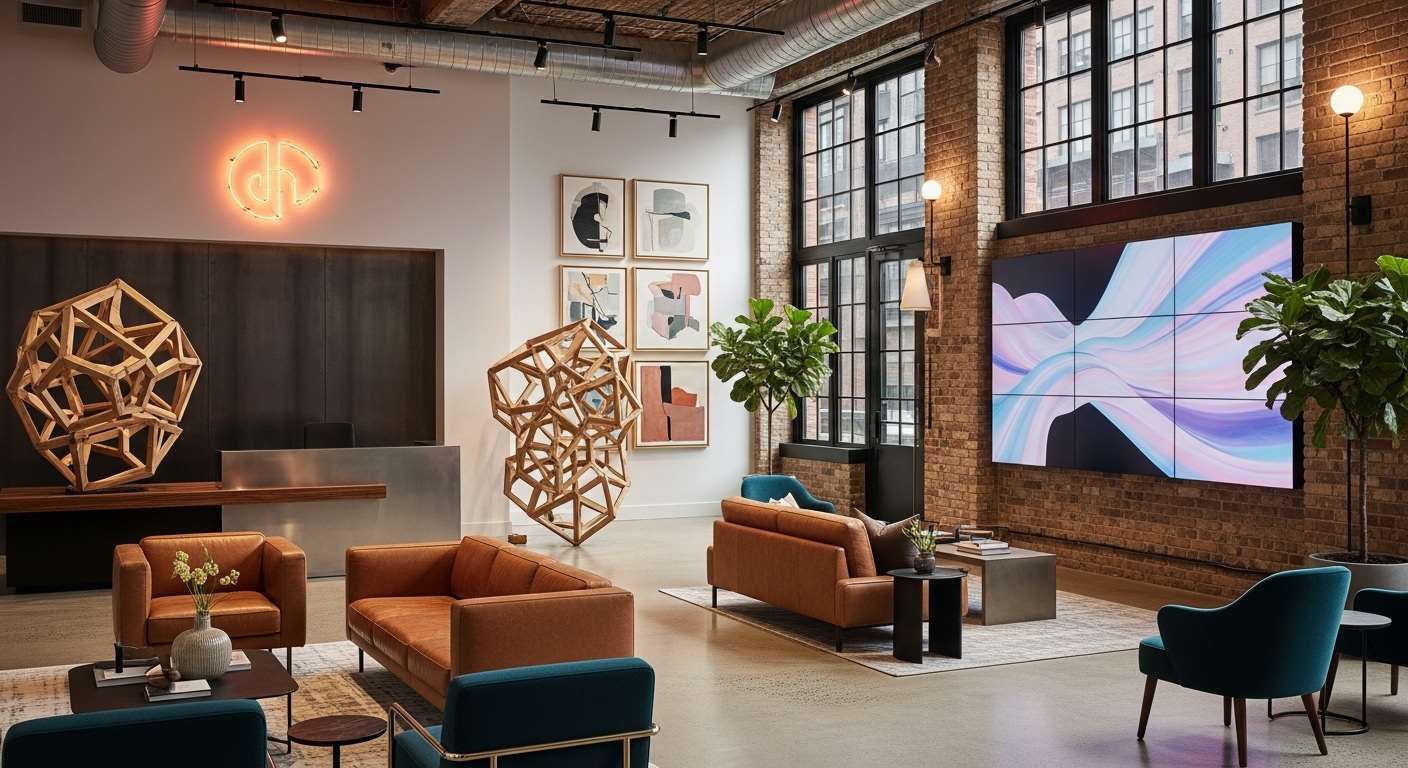In the architecture of a new workspace, we meticulously plan for plumbing, electrical grids, and HVAC systems, treating them as essential utilities. Yet, too often, the most critical modern utility—IT infrastructure—is treated as an afterthought, layered on top of a finished design. This outdated approach leads to compromised security, logistical nightmares, and costly retrofitting. The latest trends show a definitive shift towards treating IT not as a separate component, but as a foundational utility woven into the very fabric of workspace design and logistics from the initial blueprint. This integrated strategy is essential for creating the agile, intelligent, and secure environments that modern organizations demand. This guide provides a blueprint for this crucial integration, covering the entire lifecycle from architectural planning and network design to security, logistics, and smart technology deployment, ensuring your workspace is built for the future from day one.
The foundational blueprint: integrating IT in the architectural phase
The most profound and costly mistakes in IT setup occur when technology planning is divorced from architectural design. Integrating IT leaders with architects and interior designers at the conceptual stage is the single most effective way to prevent these errors. This early collaboration transforms IT from a late-stage installation into a core functional system of the building. Key considerations at this phase include the strategic placement of the server room or network closets. These spaces are the heart of the digital infrastructure and require specific planning for cooling, power, security, and fire suppression, factors that are difficult and expensive to add later. Furthermore, planning structured cabling pathways within walls, ceilings, and floors alongside electrical conduits ensures a clean, efficient, and scalable network backbone. This prevents unsightly and inefficient surface-mounted trunking and guarantees that data ports and power outlets are exactly where they are needed, supporting a flexible and dynamic workspace layout. Early planning also allows for the seamless integration of physical security measures, such as access control systems and surveillance camera placements, ensuring they are effective without detracting from the office aesthetic.
Designing the network backbone: scalability and performance
A building’s digital backbone is its network infrastructure, and its design dictates the speed, reliability, and future-readiness of the entire operation. In the initial design phase, a critical decision revolves around creating a balanced ecosystem of wired and wireless connectivity. While Wi-Fi is essential for mobility and flexibility, high-bandwidth wired Ethernet connections remain crucial for stationary workstations, servers, and critical systems that demand maximum stability and speed. A strategic design involves mapping out Wireless Access Point (WAP) locations using predictive site surveys to guarantee complete, high-performance coverage, eliminating dead zones and ensuring seamless roaming. At the same time, planning for structured cabling with high-capacity cables, such as Cat 6a or fiber optics, provides a future-proof foundation that can support next-generation technologies. Scalability is paramount; the network must be designed not just for current employee headcount but with the foresight to handle future growth in personnel and the exponential increase in connected devices, from laptops to IoT sensors. This involves selecting modular network switches and routers that allow for easy expansion, ensuring the digital infrastructure can evolve in lockstep with the organization’s ambitions without requiring a complete overhaul.
The security-first approach to physical IT design
Cybersecurity is often perceived as a purely digital discipline, but its effectiveness is deeply intertwined with the physical design of the workspace. A security-first approach embeds protective measures into the office layout, creating an environment that naturally reinforces secure behaviors. The server room, as the central nervous system of the company’s data, is the most critical area. Its design should incorporate multi-factor access control—combining key cards, biometric scanners, or PIN codes—to create a stringent, auditable entry process. The physical construction of the room itself, including reinforced walls and doors, provides a robust barrier against unauthorized physical access. Beyond this core, the placement of security cameras should be strategically planned to monitor sensitive areas, entry points, and equipment closets without infringing on employee privacy. Furthermore, workspace design can subtly guide secure practices. For instance, positioning monitors away from high-traffic hallways minimizes the risk of “shoulder surfing,” and creating designated secure zones for handling sensitive documents can prevent accidental data exposure. By integrating these physical security considerations into the initial design, you build a layered defense that makes security a seamless part of the workplace environment, not an intrusive addition.
From procurement to plug-in: the logistics of IT deployment
The logistical dimension of an IT setup is a complex ballet of timing, coordination, and precision. A flawless digital launch on day one depends on a logistics strategy that is synchronized with the overall construction or renovation timeline. This process begins with meticulous IT asset management. Every piece of hardware, from servers and switches to laptops and monitors, must be procured, cataloged, and configured well in advance. Creating a detailed inventory allows for efficient tracking and pre-deployment setup, minimizing the work required on-site. The physical transport of this sensitive and valuable equipment requires careful planning, often involving specialized logistics partners who can ensure secure, insured, and timely delivery. The most critical phase is coordinating the installation with construction milestones. For example, cabling must be run before walls are closed, and network racks must be installed before flooring is finished. This requires constant communication between the IT team, project managers, and various contractors to ensure that each dependency is met in the correct sequence. A well-executed logistics plan prevents costly delays and ensures that when employees walk in, their digital tools are ready and waiting, enabling immediate productivity.
Powering the modern workplace: redundancy and sustainability
In a digitally dependent world, power is not merely a utility; it is the lifeblood of the organization. A robust and resilient power infrastructure is non-negotiable for ensuring business continuity. The foundation of this is power redundancy, primarily through Uninterruptible Power Supplies (UPS). These battery-backup systems provide immediate protection against short-term power outages, spikes, and sags, giving critical systems like servers and network hardware enough time to either ride out the disturbance or shut down gracefully. For organizations requiring near-constant uptime, a backup generator is essential, capable of powering the entire office or at least its critical functions for an extended period. Beyond redundancy, there is a growing imperative for energy efficiency and sustainability, often termed ‘Green IT’. This involves selecting hardware with high Energy Star ratings, which consume less power and generate less heat, reducing both utility costs and the load on cooling systems. Furthermore, modern office designs can incorporate smart power distribution units (PDUs) that allow for remote monitoring and management of power consumption at the device level. This data enables IT teams to optimize energy use, contributing to the company’s sustainability goals and reducing its operational carbon footprint.
Smart office integration: weaving technology into the workspace fabric
The true potential of a modern workspace is unlocked when its digital infrastructure supports a cohesive ecosystem of smart technologies. This goes beyond basic connectivity to create a responsive, data-driven environment. The foundation laid by a robust network and structured cabling is crucial for deploying an array of Internet of Things (IoT) devices. These sensors can monitor room occupancy, air quality, and ambient light levels, feeding real-time data to a central building management system. This allows for automated adjustments to lighting and HVAC, optimizing comfort while significantly reducing energy consumption. This same network backbone supports sophisticated audio-visual (AV) systems for conference rooms, enabling seamless video conferencing and content sharing. It also powers integrated room booking systems, where digital panels outside meeting spaces display real-time availability and sync with employees’ calendars. A holistic IT setup ensures these disparate systems can communicate with each other on a unified platform, creating a truly ‘smart’ office that enhances efficiency, simplifies daily tasks, and provides valuable analytics on how the workspace is being used, informing future design iterations.
In conclusion, the era of treating IT as a separate, final step in office setup is over. A forward-thinking approach requires that digital infrastructure be considered a primary utility, as fundamental as power and water. By embedding IT planning into the earliest stages of architectural design and logistics, organizations can build workspaces that are inherently more efficient, secure, and adaptable. This blueprint—which prioritizes early collaboration, designs for scalability, integrates physical security, synchronizes logistics, ensures power resilience, and enables a smart technology ecosystem—is the definitive strategy for future-proofing a physical workspace. This deep integration not only avoids the significant costs and compromises associated with retrofitting but also creates a seamless, high-performance environment that empowers employees and provides a lasting competitive advantage. The result is a workspace that doesn’t just support the business; it actively drives it forward.





